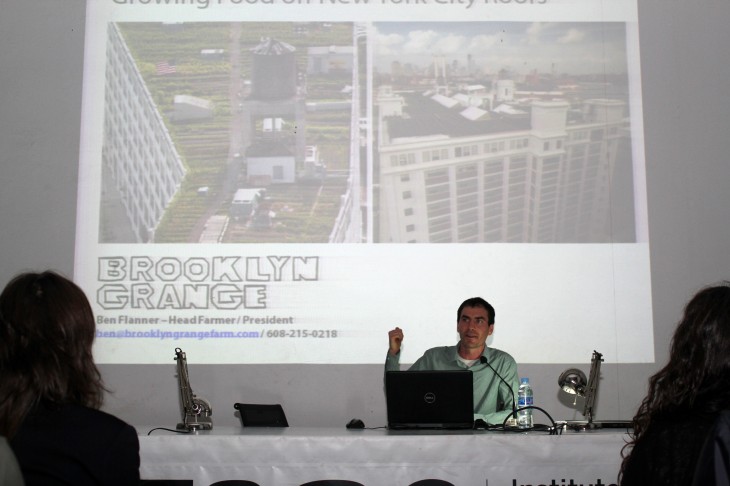Today we had the pleasure of hosting a Lecture by Ben Flanner, the head farmer and CEO of Brooklyn Grange. during the Lecture Ben described the many facets and projects of the Brooklyn Grange, a 2.5 acre rooftop farm in New York City.
As the population in cities rise, these appear to be evermore removed from nature. The farms therefore help us understand what role nature can potentially play in the city for the future.
The first rooftop farm was opened in May 2010 in Queens, on the roof of an ex-industrial building, in one of the cities up and coming spaces, where people started to move, from Manhattan, mainly for economic reasons.
The second farm, at the Brooklyn Navy yard, was then opened in May 2012, bringing production back into the city, in an affordable manner.
The project took the model of the green roof, and expanded this concept to a concrete and commercial farming operation. The model of a green roof refers to a model where vegetation is placed over the waterproofing membrane of an existing roof. This model brings with it a series of benefits that better the urban landscape, and its population, from a series of points of view: these allow to capture stormwater, allowing to minimise sewage over flow, transforming the city into a “sponge”, allowing it to capture water; it increments the building’s insulation; it helps combat the heat island effect, lowering the city’s temperature; it extends the life span of the roof, and inparticular its waterproof membrane; and finaly, it represents a real estate tax credit to the landowner.
The lecture then proceeded to explain how the farms work with respect to a series of topics, including:
- Growing, selling, and distributing food in a city, the farm being located in the city offers a 0km distribution, therefore also reducing emissions related to the distributions of its produce;
- The structural and engineering requirements for rooftop farm, with respect to the diverse layering neceassary and possible methods to install a green roof;
- Architectural requirements and important factors to consider – such as egress, structure engineering, fire code, municipal filing and tax credits;
- Social and community programs, such as the City Growers;
- Children’s nutritional education, as Diet, particularly in the United States, is a big issue that calls to be dealt with, as calories have an all time low cost, generating a stuation where people are poisoning their body at a very affordable price;
- Organic farming education and training programs, resulting in one of the more important long term factors of the project;
- Events, rooftop dinners, weddings, and the many entrepreneurial activities which occur at the farm;
- Finances – startup costs, ongoing challenges.
The Lecture was wrapped up with a question and answer period, where we discussed how city leaders and planners can learn from the Brooklyn Grange project to incorporate important environmental and community factors into design.

